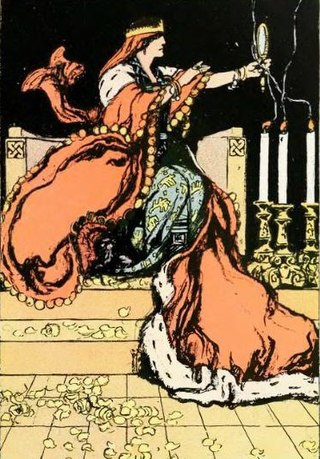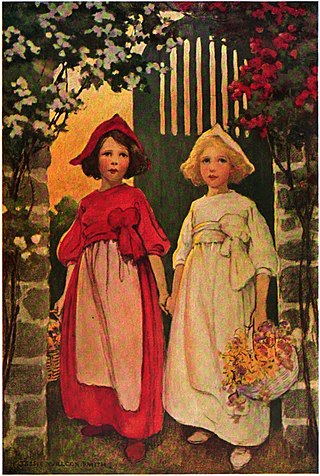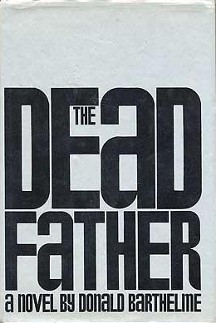
"Snow White" is a German fairy tale, first written down in the early 19th century. The Brothers Grimm published it in 1812 in the first edition of their collection Grimms' Fairy Tales, numbered as Tale 53. The original German title was Sneewittchen; the modern spelling is Schneewittchen. The Grimms completed their final revision of the story in 1854, which can be found in the 1857 version of Grimms' Fairy Tales.

"Bluebeard" is a French folktale, the most famous surviving version of which was written by Charles Perrault and first published by Barbin in Paris in 1697 in Histoires ou contes du temps passé. The tale tells the story of a wealthy man in the habit of murdering his wives and the attempts of the present one to avoid the fate of her predecessors. "The White Dove", "The Robber Bridegroom", and "Fitcher's Bird" are tales similar to "Bluebeard". The notoriety of the tale is such that Merriam-Webster gives the word Bluebeard the definition of "a man who marries and kills one wife after another". The verb bluebearding has even appeared as a way to describe the crime of either killing a series of women, or seducing and abandoning a series of women.

The Evil Queen, also called the Wicked Queen or the Queen, is a fictional character and the main antagonist of "Snow White," a German fairy tale recorded by the Brothers Grimm; similar stories exist worldwide. Other versions of the Queen appear in subsequent adaptations and continuations of the fairy tale, including novels and films. One particularly notable version is Disney's depiction, sometimes known as Queen Grimhilde. The character has also become an archetype that inspired unrelated works.
Merrill De Maris was an American writer who worked on Disney comic strips for King Features Syndicate.

Donald Barthelme Jr. was an American short story writer and novelist known for his playful, postmodernist style of short fiction. Barthelme also worked as a newspaper reporter for the Houston Post, was managing editor of Location magazine, director of the Contemporary Arts Museum in Houston (1961–1962), co-founder of Fiction, and a professor at various universities. He also was one of the original founders of the University of Houston Creative Writing Program.

"Snow-White and Rose-Red" is a German fairy tale. The best-known version is the one collected by the Brothers Grimm in 1837 in the third edition of their collection Grimm's Fairy Tales. It was first published by Wilhelm Grimm in 1827 in Wilhelm Hauff's Märchen-Almanach. An older, somewhat shorter version, "The Ungrateful Dwarf", was written by Caroline Stahl (1776–1837). Indeed, that appears to be the oldest variant; no previous oral version is known, although several have been collected since its publication in 1818. Oral versions are very limited regionally. The tale is of Aarne-Thompson type 426.

Forty Stories collects forty of Donald Barthelme's short stories, several of which originally appeared in The New Yorker. The book was first published by G. P. Putnam's Sons in 1987.

Steven Barthelme is the author of numerous short stories and essays. His published works include And He Tells the Little Horse the Whole Story, Double Down: Reflections on Gambling and Loss, and The Early Posthumous Work. His brothers Donald and Frederick also became notable authors. His father, Donald Barthelme, Sr., was a well-known modernist architect in Houston.
Snow White is a popular fairy tale.

Lawrence F. McCaffery Jr. is an American literary critic, editor, and retired professor of English and comparative literature at San Diego State University. His work and teaching focuses on postmodern literature, contemporary fiction, and Bruce Springsteen. He also played a role in helping to establish science fiction as a major literary genre.
Fredrick Barthelme is an American novelist and short story writer of minimalist fiction. He is the director of the Center For Writers at The University of Southern Mississippi and editor of the literary journal Mississippi Review. He is currently the editor of New World Writing
The Glass Mountain or Glass Mountain may refer to:
Gulf Coast: A Journal of Literature and Fine Arts is a literary magazine from Houston, Texas. Founded in 1986 by Donald Barthelme and Phillip Lopate, Gulf Coast was envisioned as an intersection between the literary and visual arts communities. As a result, Gulf Coast has partnered with the University of Houston's Creative Writing Program, the Museum of Fine Arts, Houston, and the Menil Collection to showcase some of the most important literary and artistic talents in the United States. Faculty editors past and present include Mark Doty (1999–2005), Claudia Rankine, (2006) and Nick Flynn (2007–present). The magazine publishes poetry, fiction, and creative nonfiction.

The Dead Father is a post-modernist novel by author Donald Barthelme published in 1975 by Farrar, Straus and Giroux. The book relates the journey of a vaguely defined entity that symbolizes fatherhood, hauled by a small group of people as the plot unravels through narratives, anecdotes, dialogues, reflexions and allegories presented to the reader through the tools and constructions of postmodern literature, in which the author excelled as a short story writer. Chapter 17 includes an adapted version of a previously published short story, "A Manual for Sons", that is much in the style and character of the novel.
Tracy Daugherty is an American author. He is Distinguished Professor of English and Creative Writing at Oregon State University. He has held fellowships from the Guggenheim Foundation and the National Endowment for the Arts.
Thomas Cobb is an American novelist and author of the 1987 novel Crazy Heart which was adapted into the 2010 Academy Award winning 2009 film Crazy Heart.
Federico Pedrocchi was an Italian comic book artist and writer. He sometimes used the pen name Costanzo Federici. He founded the magazine Paperino e altre avventure in 1937, and wrote some of the earliest Disney comic book stories.
Donald Duck and Other Adventures, also known as Paperino giornale, is a 1937–40 weekly Italian Disney comics magazine published by Mondadori. The comic was launched by Federico Pedrocchi, Mondadori's art director, as a companion to the existing weekly Topolino magazine. Paperino published 149 issues from 30 December 1937 to 26 October 1940, at which point it was merged with Topolino.

Paradise is a 1986 novel by American writer Donald Barthelme. The novel concerns an architect, Simon, and his creation of an apparent paradise for himself.










